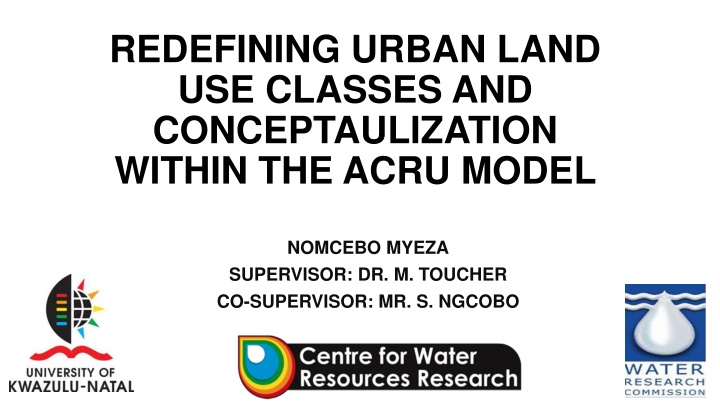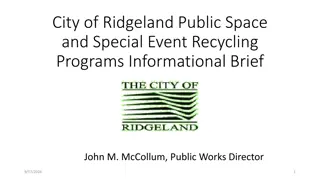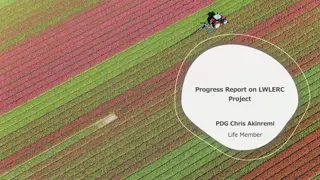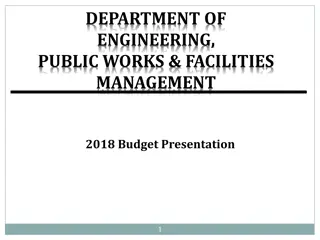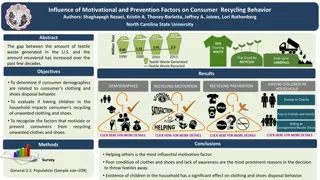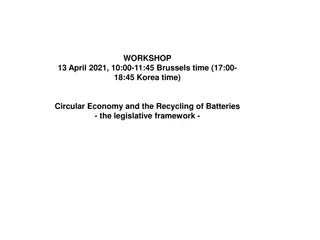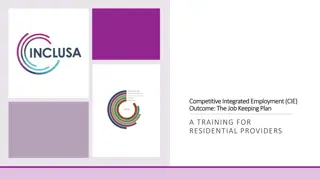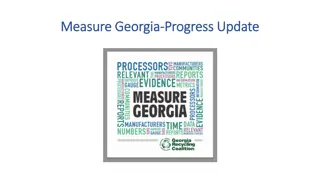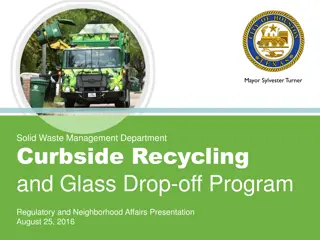SILOS AND SLOGANS: Importance of Nature, Employment, Education, and Recycling
In this analysis, various topics such as groceries, employment, nature conservation, education, and waste management are discussed through slogans, linear regression, targeted actions, and phases involving pollers and recyclers. The content emphasizes the significance of nature, employment opportunities, the importance of education, and the need for proper waste separation and recycling.
Download Presentation

Please find below an Image/Link to download the presentation.
The content on the website is provided AS IS for your information and personal use only. It may not be sold, licensed, or shared on other websites without obtaining consent from the author.If you encounter any issues during the download, it is possible that the publisher has removed the file from their server.
You are allowed to download the files provided on this website for personal or commercial use, subject to the condition that they are used lawfully. All files are the property of their respective owners.
The content on the website is provided AS IS for your information and personal use only. It may not be sold, licensed, or shared on other websites without obtaining consent from the author.
E N D
Presentation Transcript
REDEFINING URBAN LAND USE CLASSES AND CONCEPTAULIZATION WITHIN THE ACRU MODEL NOMCEBO MYEZA SUPERVISOR: DR. M. TOUCHER CO-SUPERVISOR: MR. S. NGCOBO
INTRODUCTION South Africa s urban population has grown from 53% in 1996 (DEAT, 2005) to 65.3% in 2016 (World bank, 2016) South Africa s urban landscape has expanded and changed with growing urban populations Urban areas replaces permeable vegetated surfaces with impervious surfaces: altering the partitioning of rainfall impeding rainfall infiltration increasing speed and volume of surface runoff increasing downstream peakflows reducing groundwater recharge and often through treatment work discharge reducing the variability of flows downstream It is important that the relationship between urban areas and catchment hydrological response are understood and quantified. Thus, urban areas need to be adequately accounted for in hydrological models.
INTRODUCTION This project forms part of a WRC funded project which will be using the ACRU agrohydrological model, therefore this project focused on this model. Conceptualisation of urban areas in ACRU Impervious areas are considered to be either adjunct or disjunct. Adjunct impervious areas are those which contribute to directly, on the same day, to a channel (Schulze, 1995). Disjunct impervious areas are those where the runoff from them flows onto a pervious area and contributes to the soil water budget and runoff response of the pervious area (Schulze, 1995). A portion of the rainfall which falls on the impervious surfaces, both adjunct and disjunct surfaces, is intercepted by, and stored, on the surface as depression storage. The rainfall stored as depression storage is evaporated using the daily A-pan equivalent evaporation rate as reference potential evaporation. Where the stored water is not fully evaporated on the day of the event, it is carried over to the following day (Schulze, 1995). The fraction of adjunct and disjunct impervious areas are specified in the inputs to the model for each catchment considered.
INTRODUCTION Following a review of several hydrological models, the conceptualisation of impervious areas in ACRU was thought to be adequate, however the values suggested by Tarborton and Schulze (1992) are no longer appropriate as the nature of South Africa s urban areas has changed. Aim: To develop a methodology for estimating new urban land use classes with percentage imperviousness, percentage adjunct and disjunct impervious areas which reflect the current nature of South Africa s urban areas. To estimate the percentage imperviousness, percentage adjunct and disjunct impervious areas for the Limpopo North Water Management Area
STUDY CATCHMENTS STUDY CATCHMENTS Given the aims of the larger WRC project the study will focus on the Limpopo North Water Management Area
URBAN LAND USE CLASSIFICATION URBAN LAND USE CLASSIFICATION Table 1: National Landcover 2000 relative to the new land use classification NLC (2000) does not account for recreational areas and informal settlements both of which will be included in the new classification
Figure 2: Example of smallholding in Limpopo North WMA Figure 1: Example of smallholding in Limpopo North WMA
URBAN LAND USE CLASSIFICATION URBAN LAND USE CLASSIFICATION Smallholdings Small-scale farming (subsistence and commercial) found on city outskirts Predominantly pervious surfaces (natural vegetation and cultivation) Limited impervious surfaces in the form of storage sheds and scattered formal housing Low percentage imperviousness thus a low surface runoff potential Lack stormwater drainage systems due to their limited imperviousness
IMPERVIOUS SURFACES IMPERVIOUS SURFACES Figure 3: Smallholding ( 0.5 km2) Figure 4: Smallholding ( 0.5 km2)
IMPERVIOUS SURFACES IMPERVIOUS SURFACES Table 2: Percentage imperviousness of 10 0.5km2 areas in smallholding land use 0.5km2 area 1 2 3 4 5 6 7 8 9 10 Impervious area (km2) 0.04944 0.00122 0.00427 0.01140 0.01416 0.00347 0.00437 0.01647 0.00627 0.00867 % imperviousness 4.94 0.12 0.43 1.14 1.42 0.35 0.44 1.65 0.63 0.87 Average % imperviousness 1.20%
URBAN LAND USE CLASSIFICATION URBAN LAND USE CLASSIFICATION Commercial Area/ Central Business District Characterised by high density buildings (shopping malls, warehouses, offices), parking lots and paved areas High percentage impervious area High runoff potential Pervious surfaces present in form of lawns and parks Well drained with stormwater drainage systems Includes transport routines (roads and railways)
Figure 6: Example of central business district in Limpopo North WMA Figure 5: Example of central business district in Limpopo North WMA
IMPERVIOUS SURFACES IMPERVIOUS SURFACES Table 3: Percentage imperviousness of 10 0.5km2 areas in central business district 0.5km2 area Impervious area (km2) % imperviousness 1 0.57362 57.36 2 0.24033 24.03 3 0.36207 36.21 4 0.15292 15.29 5 0.16627 16.63 6 0.10548 10.55 7 0.26783 26.78 8 0.30051 30.05 9 0.16074 16.07 10 0.08590 8.59 Average % imperviousness 24.16%
IMPERVIOUS SURFACES: ADJUNCT/DISJUNCT IMPERVIOUS SURFACES: ADJUNCT/DISJUNCT Adjunct impervious areas: roads and roof tops connected to stormwater drainage systems Disjunct impervious areas: Parking lots and paved areas
CONCLUSION CONCLUSION New values will be used to model urban areas in WMA and compared to those modelled using values by Tarborton and Schulze (1992) This study provides more reliable percentage imperviousness, percentage adjunct and disjunct impervious areas in Limpopo North WMA Values by Tarborton and Schulze (1992) are default values for when only estimates of percentage imperviousness are known from urban land use descriptions Methodology may be replicated in other catchments improving ACRU s ability to adequately represent and model the modern landscape
ACKNOWLEDGMENTS ACKNOWLEDGMENTS
